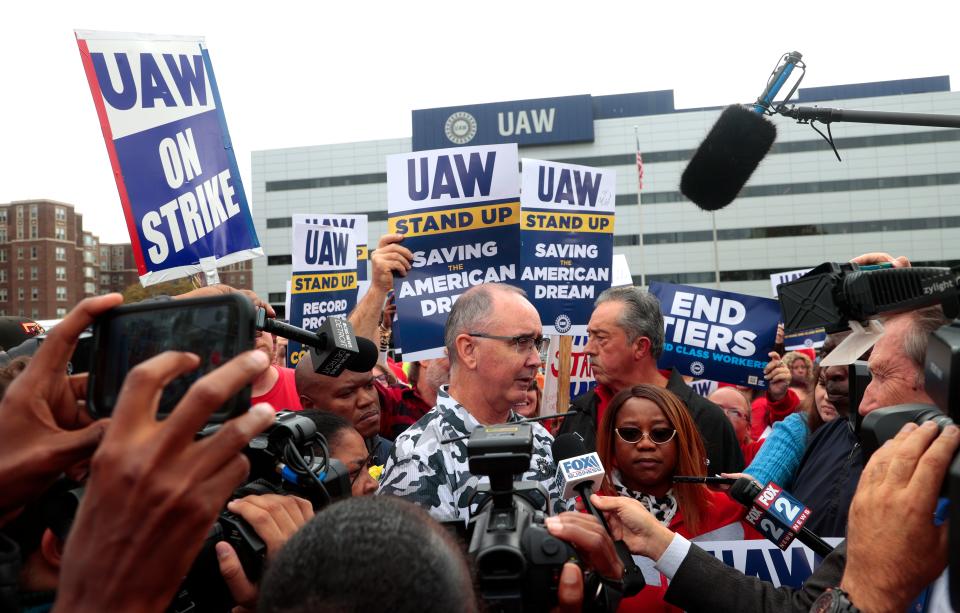UAW strike talks show progress with Ford, Stellantis. A deal may be closer than we think. | Opinion
Believe it or not, the United Auto Workers and the Detroit Three automakers are making progress toward a deal.
This year's unconventional, contentious bargaining, the parties' public statements and postures and the UAW's ongoing strike — last Friday, UAW President Shawn Fain announced a third wave of strikes, now encompassing 25,000 workers across 41 Ford Motor Co., GM and Stellantis sites ― can obscure that.
Fain’s announcement came at the end of a week filled with heightened tensions. Ford had paused construction of its battery production plant in Marshall, while two presidential visits had interjected politics into bargaining. As if this were not enough, violence directed at strikers occurred at several sites across the country.

Both sides have grown testy in their public statements. General Motors CEO Mary Barra laid it on the line, saying that the UAW leadership's "plan from the beginning has been to drag their membership into a long, unnecessary strike to further their own personal and political agendas." The UAW retorted on X that "Mary Barra did not show up to bargaining this week."
Despite all of that, the parties aren't that far apart on key issues, particularly at Ford and Stellantis. And reviewing the progress the parties have made provides insight into the path to a final settlement.
Readers on UAW strike: Here's a math lesson for Detroit 3 execs
The UAW and the Detroit 3 automakers have common interests
The United Auto Workers and the Detroit Three bring competing perspectives to the bargaining table.
Autoworkers seek record contracts that reflect record profits and a "fair and just" transition to electric vehicles. Automakers emphasize competitiveness and managerial flexibility. From these vantage points, the parties take specific positions on economic and noneconomic issues.
The union members’ demands fall into three categories.
Job and income security: proposals granting the right to strike plant closures; limitations on outsourcing and income and healthcare for laid off workers.
Increased compensation and pay equity: wage increases (initially 46% over four years), restoration of cost of living, elimination of tiers and expedited paths for temporary employees to transition to full-time status.
Work-life balance: paid time off and a four-day work week.
The UAW has a fourth overarching objective: The union wants the companies to bring planned electric vehicle production, like assembly plants and battery-producing joint ventures, under the union's national master contracts.
For those jobs to become part of the UAW contract would require retooling existing plants to produce electric vehicles and parts, and facilitating union recognition of new assembly and battery sites, including those operating under joint ownership with foreign-based companies. New plants would become a point of contention, with the UAW seeking that union contracts carry over to the new sites, and automakers saying the UAW has to organize those workers.

The Big Three’s proposals have largely responded to the union’s demands, plus the companies' own performance-related considerations, such as Stellantis’ well-publicized efforts to reduce absenteeism on the shop floor.
Analysts estimate that the full cost of the union’s demands would more than double the average hourly labor costs of the companies, which now hover around $65, compared to $55 for the foreign automakers and $45 to $50 an hour for Tesla. Investors flinch at the prospect of such a steep climb, fearing such largesse would return the automakers to the financial precarity of 15 years prior.
More from Freep opinion: Poll workers are afraid to work 2024 election. Take Trump, MAGA mob's threats seriously.
The companies — eager to placate investors by preserving what they view as competitiveness and flexibility — have balked at restoring retiree healthcare and defined benefit pension plans, resisted a 32-hour work week and viewed union representation of joint ventures as a matter for the union to take up with the management at specific sites. In certain cases, the automakers want to keep using temporary employees to maintain staffing flexibility.
Ford, Stellantis are making progress
Ford and Stellantis have made offers narrow the gap on key items. Based on what we know, the greatest divide is between the UAW and GM.
Ford has offered to raise pay by 20% (not compounded); restore the cost of living allowance; eliminate tiers at plants in Rawlinson and Sterling Heights; transition temps to full-time status within three months of continuous service; reduce the time required for employees to move to the top wage rate from eight to four years; grant workers the right to strike over plant closures; increase company contributions to defined contribution plans; grant laid off workers two years of pay with health care; make capital investments in all North American facilities; increase profit-sharing payments by more than 13%; add a paid holiday (Juneteenth); provide two weeks paid parental leave.

Stellantis has offered to raise pay by 20% (not compounded); provide for a cost of living allowance if the Consumer Price Index, the government's measure of inflation, exceeds 3%; eliminate tiers at MOPAR (the company's parts, service, and customer care division); grant workers the right to strike over plant closures and impose moratoriums on outsourcing; grant workers the right to not cross picket lines; give workers the ability to purchase an annuity guaranteeing lifetime income payments; add the Juneteenth paid holiday; allow employees to contribute up to 6% (on top of the company’s 6%) to defined contribution plans that would be matched by the company at 50%; contribute $1 per hour for healthcare to defined contribution plans.
GM has offered to eliminate tiers at its Customer Service and Aftersales and Components Holding units; shorten the move from the bottom to top wage tier from eight to four years; raise wages by 20% (not compounded); provide for cost of living adjustments if inflation exceeds workers’ wage increases; provide majority pay for limited time for laid off workers; raise temp wages to $20 per hour; make a $1,000 additional contribution to defined contribution plans; provide a 25% increase in retirement healthcare contribution to defined contribution plans; provide two weeks parental paid leave; add the Juneteenth holiday; make a $500 payment to retirees. The expanded right to strike, cost of living adjustments, job security protections and a path to full employment for temporary workers remain points of contention.
Getting to a deal
How can the parties now close the deal?
By focusing on their common interest: Ensuring the businesses are successful enough to invest plentifully in the future.
There are options to close the gaps.
These include making multiple offers with evident tradeoffs between them to reveal the other side’s preferences for an overall package. The parties might also consider contingency contracts that tie increasing retirement funds to earned profits. In addition, they may agree that the companies would recognize the UAW at planned EV plants operated by the companies. Finally, both sides may agree to pilot programs to experiment with alternative work weeks.
In other words, to succeed, the parties must exhibit a certain degree of flexibility, and give-and-take. But such is the nature of collective bargaining — and despite each side's fiery rhetoric, compromise remains possible.
Marick F. Masters is a professor of business at Wayne State University. Submit a letter to the editor at freep.com/letters.
This article originally appeared on Detroit Free Press: UAW strike negotiations show progress with Ford. Is a deal coming?

